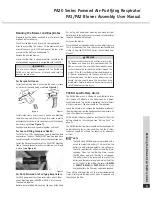
4
PA20 Series Powered Air-Purifying Respirator
PA1/PA2 Blower Assembly User Manual
Mounting the Breathing Tube on the
PA1BU/PA2BU Blower
Ensure that a gray rubber gasket is in place in the
breathing tube coupler on the blower unit.
Screw one end of the breathing tube into the blower unit
(hand tight is sufficient)
(see Figure 2)
.
Ensure that the ON/OFF Switch is in the OFF position.
Ensure that neither the breathing tube nor the filter is
blocked.
Switch on the blower. For the PA1BU blower, if the Low
Battery Alarm sounds at this time, the battery needs to be
recharged. See notes on previous page regarding properly
charging the battery.
Figure 2
Checking Airflow with the Airflow
Indicator (PA1AFI)
Take the free end of the breathing tube in one hand, hold it
upright and place the Airflow Indicator into the end of the
tube
(see Figure 3)
.
Ensure that the air outlet holes in the Airflow Indicator
tube are not blocked.
Apply a light downward pressure to the Airflow Indicator
to get a reasonable seal at the breathing tube end. Two
hands may be used if preferred, one to hold the breathing
tube and one to hold the Airflow Indicator.
The position of the ball in the Airflow Indicator should be
observed. If any part of the ball is below the PASS LINE on
the Airflow Indicator, check for:
• Clogged or damaged air-purifying filter element. See
“Replacing the PA1FG High Efficiency Filter” on the
next page for filter mounting instructions.
• Low battery charge or battery malfunction.
• Blower malfunction.
If the ball is completely above the PASS LINE on the Airflow
Indicator then the system is ready for use.
NOTE
Due to the back-pressure of the ball, the Low
Battery Alarm may sound when a reading is being
taken. If the ball bounces, let it stabilize, and then
read the lowest point.
When the blower passes the flow test, it is ready to use.
Turn off the blower, remove the flow indicator and store the
air flow indicator safely for future use.
NOTE
Use ONLY Bullard High Efficiency Filter No. PA1FG,
which complies with and has the NIOSH approval
label.
If the blower malfunctions during use in a hazardous
area:
DO NOT
remove the respiratory inlet covering, blower
or waist-belt while in the hazardous area.
DO
remain calm and
LEAVE
the hazardous area
immediately.
After reaching a hazard-free area, immediately remove
the hood and respirator.
DO NOT
use a blower that fails the flow test.
Failure to observe these warnings could result in death
or serious injury.
WARNING
Mounting the Br
eathing T
ube/Checking Airflo
w
Figure 3





















